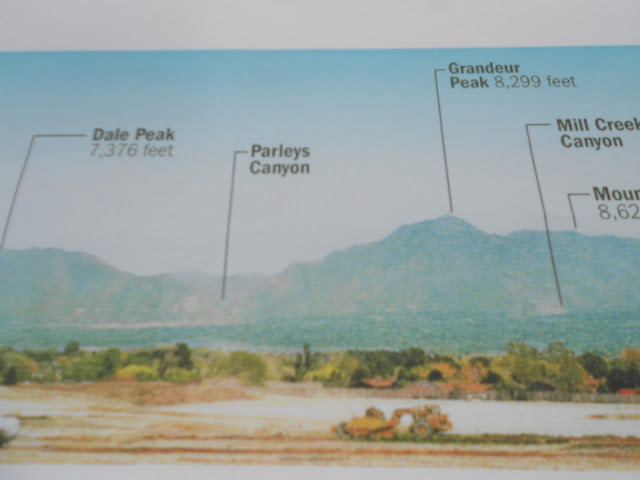THE most striking geographical features in Salt Lake County are the Wasatch Mountains on the east side of the valley.
Rising sharply 7,000 feet above the valley floor, the Wasatch Mountains create natural landmarks in Salt Lake County. (The Oquirrh Mountains dominate the west side of the valley.)
We take these mountains for granted, and while we may enjoy their inspiring, majestic beauty, their place as natural directional landmarks may not be appreciated until we visit a region that is flat.
(See the photos below for the peak/canyon names of S.L. mountains.)
(See the photos below for the peak/canyon names of S.L. mountains.)
"When I drive through Kansas or Nebraska, I wonder how people know where they're going" Dale J. Green, a past president of the Wasatch Mountain Club, said.
Green started hiking the Wasatch Mountains in 1953 and believes he may have hiked almost every trail in Salt Lake County. He said his favorite peak is the "Pfeifferhorn," not visible from most of the Salt Lake Valley but located between American Fork Twin Peaks and Lone Peak on the south side of Little Cottonwood Canyon.
Charles L. Keller is another longtime Salt Lake hiker who is wrote a book on the Wasatch Mountains, "The Lady in the Ore Bucket."
"They're my church," Keller said of the Wasatch Mountains. "I've spent the last 40 years trampling over them."
He especially loves Little and Big Cottonwood canyons and Mill Creek Canyon. His favorite hike is up Kessler Peak.
"It's steep, and there's no easy way up," he said.
Keller agrees it is too easy for Salt Lakers to take these mountains for granted.
These mountains are home to many animals, offer year-round recreational activities and are important watersheds — a critical factor each year.
The Wasatch Mountains are also the reason we have substantial water in the Salt Lake area.
"They're the main source of water for Salt Lake," said Brian McInerney, a hydrologist with the Salt Lake office of the National Weather Service.
Without the mountains, the storms would just keep moving by without raining or snowing here, and there would be neither the snowpack to fill the reservoirs nor the recharging of groundwater supplies.
McInerney said mountains substantially change how air circulates in the area.
Perhaps the most dramatic view of Salt Lake's segment of the Wasatch Mountains can be enjoyed from near the north end of Beck Street. Here, the peaks all seem compacted together, rising sharply above the city's downtown skyline.
What's the tallest peak in Salt Lake County? How many names of the peak do you know? Where did the peak names originate?
The Twin Peaks (11,489 and 11,433 feet above sea level) are the tallest summits in Salt Lake County, but where are they located? Could you point out Mount Olympus, Farnsworth, Lone Peak or Wire Mountain? You probably know where Little and Big Cottonwood canyons, Mill Creek and Parleys canyons are, yet could you pinpoint Bells, Ferguson or Heughs canyons?
One of the most surprising things about the names of Salt Lake County mountain peaks is the repetition of Twin Peaks. There are no less than three sets of Twin Peaks in the Salt Lake section of the Wasatch Mountains listed on maps. Don't get lost or in trouble on one of these peaks, because who will know which one you're on? (You would think a name like "Double Peaks" or "Dual Peaks" would have been used instead of Twin Peaks three times.)
The "Broads Fork" Twin Peaks are perhaps the most noticeable of the three Twins in Salt Lake County. They also
contain the Twin Peaks Wilderness Area and are located
more near the center of the Salt Lake Valley than the other
"Twins."
(-Distilled from an article in the Deseret News, by Lynn Arave, on Aug. 2, 2001.)
THE NAMES of SALT LAKE COUNTY'S MOUNTAIN
PEAKS, from north to south --- below
Photographs by Scott Winterton
Like the Wasatch Mountains?
Consider buying my new book, "Images of America Wasatch Mountains."
You can buy the book on Amazon.
-NOTE: The author, Lynn Arave, is available to speak to groups, clubs, classes or other organizations about Utah history at no charge. He can be contacted by email at: lynnarave@comcast.net













Very nice! Where, may I ask, did you find the picture? I've been looking all over for something similar. Thanks!
ReplyDeletelived here most of my life and did not know all the peaks that surround me. Thanks for the pix.
Delete